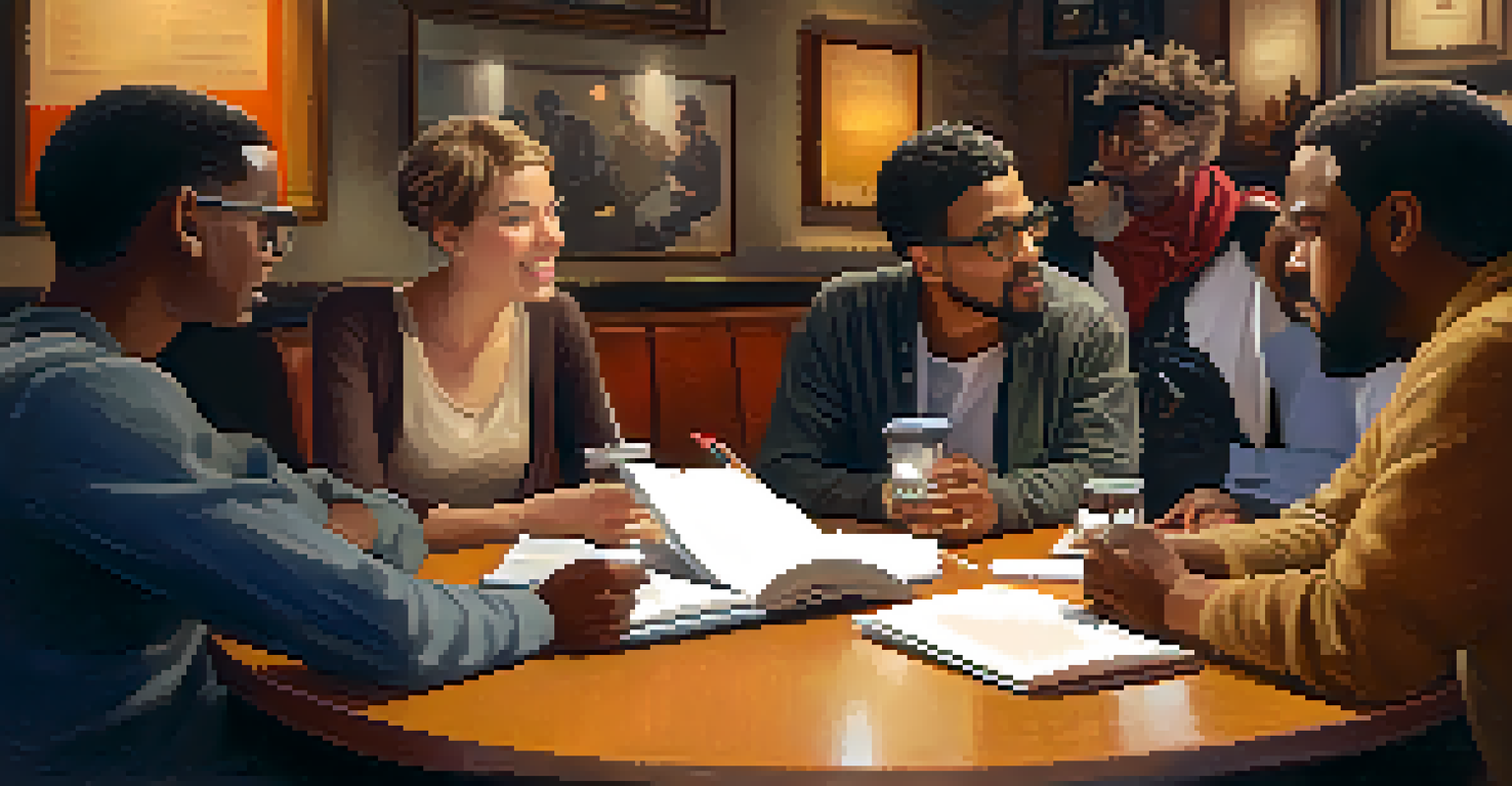The Rise of Online Film Criticism: A New Era

The Shift from Traditional to Digital Film Criticism
In the past, film criticism was largely confined to print media, with established critics holding sway over public opinion. Now, the digital age has ushered in a whole new landscape, where anyone with internet access can share their thoughts on films. This transition has democratized film criticism, allowing diverse voices to emerge and flourish, offering fresh perspectives that traditional critics might overlook.
The internet has democratized film criticism, allowing for a diverse array of voices to be heard.
Platforms like blogs, social media, and video channels have enabled passionate film enthusiasts to critique and analyze films in real time. For instance, YouTube channels dedicated to film reviews have garnered massive followings, often rivaling traditional publications. This shift not only broadens the conversation around cinema but also encourages filmmakers to pay attention to audience feedback.
As a result, the influence of online critics is growing, often shaping the narratives surrounding new releases. With more people turning to online sources for film recommendations, traditional critics are adapting their approaches to stay relevant in this new era. Ultimately, this shift signifies a more inclusive and vibrant cinematic dialogue.
The Role of Social Media in Film Criticism
Social media platforms have become pivotal in how film criticism is shared and consumed. Sites like Twitter, Instagram, and TikTok allow users to express their thoughts quickly, often using hashtags to join broader conversations about specific films. This immediacy not only engages audiences but also fosters a sense of community among film lovers.

Moreover, social media enables critics to connect directly with their audiences, leading to a more interactive experience. Viewers can ask questions, share their interpretations, and even influence future content by voicing their preferences. For example, a trending hashtag can propel a lesser-known film into the spotlight, demonstrating the power of collective opinion.
Democratization of Film Criticism
The digital age has opened up film criticism to diverse voices, allowing anyone with internet access to share their perspectives.
However, the rapid pace of social media can sometimes lead to superficial analysis. Critics must strike a balance between engaging their audience and providing in-depth insights. This evolving dynamic challenges both critics and audiences to think critically about the content they consume and share.
Diversity of Voices in Online Film Criticism
One of the most significant benefits of online film criticism is the increased diversity of voices contributing to the conversation. Historically, film criticism has often been dominated by a homogeneous group of writers, but the internet has opened the doors for underrepresented communities. From LGBTQ+ critics to those from various cultural backgrounds, the range of perspectives is broader than ever.
In the digital age, engagement between critics and audiences transforms film appreciation into a collaborative art.
This diversity enriches the discourse around films, allowing audiences to see stories through different lenses. For example, a critic from a marginalized community might highlight themes of representation and identity that others might miss. This not only enhances the viewing experience for audiences but also encourages filmmakers to consider a wider array of stories.
Ultimately, this influx of diverse voices is shaping the future of film criticism. As more people share their unique perspectives, the industry itself is likely to evolve, leading to a richer tapestry of storytelling in cinema. This new landscape invites everyone to participate, making film appreciation an inclusive experience.
The Impact of Streaming Services on Film Criticism
The rise of streaming services like Netflix, Hulu, and Amazon Prime has revolutionized how films are consumed and critiqued. With a vast library of films available at our fingertips, audiences are exposed to a wider range of content than ever before. This accessibility allows for more frequent discussions on films that may not have received traditional theatrical releases.
Critics now have the opportunity to explore and analyze films from various genres and countries that might have been overlooked. Streaming platforms often release a mix of indie films, international features, and mainstream blockbusters, providing a rich ground for critique. For instance, a lesser-known foreign film can gain traction through word-of-mouth on social media, prompting discussions that might not have occurred in a traditional setting.
Social Media Shapes Critique Culture
Platforms like Twitter and TikTok enable real-time discussions and foster community engagement among film enthusiasts.
However, the sheer volume of content can also lead to challenges for critics. With so many films to watch and analyze, it can be difficult to maintain depth in criticism. Critics are thus encouraged to focus on quality over quantity, ensuring that their analyses remain insightful and meaningful amidst the noise of endless options.
The Evolution of Film Criticism Formats
Gone are the days of traditional written reviews being the sole format for film criticism. Today, critics are experimenting with various formats, from podcasts and video essays to social media snippets. This evolution not only caters to different audience preferences but also allows for creativity in how films are discussed and critiqued.
For instance, video essays can combine visual elements with analysis, enhancing the viewer's understanding of cinematic techniques. Similarly, podcasts offer a conversational format that allows listeners to engage with critiques while multitasking. These varied formats make film criticism more accessible, inviting more people to join the conversation.
However, this shift also raises questions about the depth of analysis. Critics must navigate the balance between engaging content and thorough critique, ensuring that their insights remain valuable. As formats continue to evolve, the challenge will be to maintain the essence of thoughtful criticism while embracing new ways to connect with audiences.
Engagement: A Two-Way Street in Film Criticism
In the realm of online film criticism, engagement is no longer a one-way street. Audiences are encouraged to share their opinions and join discussions, creating a dynamic dialogue between critics and viewers. This interactive nature fosters a sense of community, as film lovers come together to explore their shared passion.
Critics who actively engage with their audience often find that this interaction enriches their own understanding of films. By considering diverse viewpoints, they can refine their analyses and address blind spots in their critique. For example, responding to comments on a review can lead to deeper insights and enhance future content.
Evolving Formats for Film Reviews
Critics are now utilizing various formats, such as podcasts and video essays, to make film criticism more accessible and engaging.
This reciprocal relationship not only elevates film criticism but also empowers audiences to become more discerning viewers. As they share their thoughts and insights, they contribute to a more robust conversation, making film criticism a collaborative art. In this way, online platforms have transformed film appreciation into a communal experience.
The Future of Film Criticism in the Digital Age
As we look ahead, the future of film criticism in the digital age seems promising yet challenging. With the continued evolution of technology and shifting audience preferences, critics must adapt to remain relevant. This means embracing new platforms, formats, and engagement strategies to connect with viewers effectively.
Moreover, the demand for authenticity and transparency is growing. Audiences are increasingly seeking critics who are genuine in their analyses and who reflect diverse perspectives. This trend emphasizes the importance of building trust with audiences, ensuring that critiques are rooted in thoughtful analysis rather than sensationalism.

Ultimately, the rise of online film criticism marks a new era filled with potential. As more voices join the conversation, the landscape of film appreciation will continue to evolve, leading to richer discussions and a deeper understanding of cinema. In this ever-changing environment, the art of critique will remain vital in shaping the future of film.